- How to Adjust X and Y Axis Scale in Arduino Serial Plotter (No Extra Software Needed)Posted 5 months ago
- Elettronici Entusiasti: Inspiring Makers at Maker Faire Rome 2024Posted 5 months ago
- makeITcircular 2024 content launched – Part of Maker Faire Rome 2024Posted 7 months ago
- Application For Maker Faire Rome 2024: Deadline June 20thPosted 9 months ago
- Building a 3D Digital Clock with ArduinoPosted 1 year ago
- Creating a controller for Minecraft with realistic body movements using ArduinoPosted 1 year ago
- Snowflake with ArduinoPosted 1 year ago
- Holographic Christmas TreePosted 1 year ago
- Segstick: Build Your Own Self-Balancing Vehicle in Just 2 Days with ArduinoPosted 1 year ago
- ZSWatch: An Open-Source Smartwatch Project Based on the Zephyr Operating SystemPosted 1 year ago
Water Tank level display with Arduino
We present the candidature of Mr. Danilo Abbasciano that is proposed for the realization of the firmware for the TiDiGino project and that presents us an application with Arduino: Display the level of a tank.
The project reads and displays the height of water level in a well or a cistern.
We will use the open source Arduino hardware device, an ultrasonic Parallax sensor to measure the height of the water, a 16 x 2 LCD display with Hitachi HD44780 driver and a buzzer that is activated when the level exceeds the threshold.
The project, as we have already mentioned, is composed of several parts. A sonar sensor to be placed at the top of the well (at a safe distance from water level) that points downward so as to measure the distance between the point of placement (in our case the highest point of the well) and the surface water. Taking a simple difference between known quantities: the distance between the bottom and the measurement read from the sensor, we get the height of the water surface. Knowing the surface of the well also it is easy to calculate the volume of water present. At predetermined intervals Arduino reads the distances and displays the height and volume of water in the well.
There is a horizontal bar that shows the trend in relative water level inside the well for an easily and immediately read.
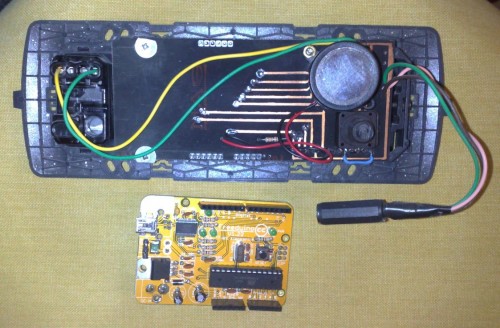
If the level exceeds a first threshold warning triggered the alarm buzzer to beep slowly if the level exceeds the second threshold, the ringing frequency increases until the level will drop back below the threshold or when you manually turn off the ringer through a button.
Arduino controls the operating logic, using the following sketches:
/* -*- mode: c -*- */
/**
* pozzo.pde
* version: 1.2
*/
#include <LiquidCrystal.h>
#define PING_PIN 13
#define BUZZER_PIN 8
#define SWITCH_INT 0 /* 0 => pin 2 */
#define PI 3.1415926535898
#define SUPERFICE_BASE (R_POZZO * R_POZZO * PI)
#define SIZE_BAR (16 * 5)
#define ALARM_ICON 0 /* code */
#define SOUND_ICON 6 /* code */
#define SOUND_ICON_ON 7 /* code */
#define R_POZZO 0.5 /* raggio pozzo (m) */
#define H_POZZO 146.0 /* cm */
#define SOGLIA_ALLARME_1 100 /* cm */
#define SOGLIA_ALLARME_2 120 /* cm */
#define DELAY_0 60000 /* ms; 1000 * 60 * 1 = 1 min */
#define DELAY_1 600 /* ms */
#define DELAY_2 200 /* ms */
/* initialize the library with the numbers of the interface pins */
LiquidCrystal lcd(12, 11, 5, 4, 3, 6);
int mute = 0;
byte *getChar(int n, byte newChar[]) {
int i;
byte code[5] = {
B10000,
B11000,
B11100,
B11110,
B11111};
for (i = 0; i < 8; i++)
newChar[i] = code[n - 1];
return newChar;
}
void setup() {
int i;
float h;
byte newChar[8];
/* set up the LCD's number of rows and columns: */
lcd.begin(16, 2);
for (i = 1; i < 6; i++)
lcd.createChar(i, getChar(i, newChar));
newChar = {
B00000,
B00100,
B01010,
B01010,
B11111,
B00100,
B00000,
};
lcd.createChar(ALARM_ICON, newChar);
newChar = {
B00011,
B00101,
B11001,
B11001,
B11001,
B00101,
B00011,
};
lcd.createChar(SOUND_ICON, newChar);
newChar = {
B00100,
B10010,
B01001,
B01001,
B01001,
B10010,
B00100,
};
lcd.createChar(SOUND_ICON_ON, newChar);
pinMode(BUZZER_PIN, OUTPUT);
/**
* LOW to trigger the interrupt whenever the pin is low,
* CHANGE to trigger the interrupt whenever the pin changes value
* RISING to trigger when the pin goes from low to high,
* FALLING for when the pin goes from high to low.
*/
attachInterrupt(SWITCH_INT, button, RISING);
/* initialize serial communication */
Serial.begin(9600);
}
void loop() {
long hWatherCm;
int litres;
hWatherCm = read_height();
if (check_alarm(hWatherCm) != 0) /* read again wather height */
hWatherCm = read_height();
lcd.clear();
print_histogram(hWatherCm);
lcd.setCursor(0, 1);
lcd.print(hWatherCm);
lcd.print(" cm - ");
// litres = SUPERFICE_BASE * (hWather / 100.0) * 1000
litres = floor(SUPERFICE_BASE * hWatherCm * 10);
lcd.print(litres);
lcd.print(" l ");
lcd.setCursor(14, 1);
lcd.write(SOUND_ICON);
lcd.setCursor(15, 1);
if (!mute)
lcd.write(SOUND_ICON_ON);
else
lcd.write('X');
/*
Serial.print("cm = ");
Serial.println(hWatherCm);
*/
switch (check_alarm(hWatherCm)) {
case 1:
lcd.setCursor(0, 0);
lcd.write(ALARM_ICON);
buzz(200);
delay(DELAY_1);
break;
case 2:
lcd.setCursor(0, 0);
lcd.write(ALARM_ICON);
buzz(200);
delay(200);
buzz(200);
delay(DELAY_2);
break;
case 0: // no alarm
delay(DELAY_0);
}
}
void print_histogram(int hWatherCm) {
int i;
int bloks;
float histogram;
// hWatherCm : HPOZZO = histogram : SIZE_BAR
histogram = (SIZE_BAR * hWatherCm) / H_POZZO;
histogram = histogram + 0.5;
bloks = (int)histogram / 5;
for (i = 0; i < bloks; i++)
lcd.write(5);
if ((int)(histogram) % 5 > 0)
lcd.write((int)(histogram) % 5);
}
long read_height() {
/**
* establish variables for duration of the ping,
* and the distance result in centimeters:
*/
long duration, hWatherCm;
/**
* The PING))) is triggered by a HIGH pulse of 2 or more microseconds.
* Give a short LOW pulse beforehand to ensure a clean HIGH pulse:
*/
pinMode(PING_PIN, OUTPUT);
digitalWrite(PING_PIN, LOW);
delayMicroseconds(2);
digitalWrite(PING_PIN, HIGH);
delayMicroseconds(5);
digitalWrite(PING_PIN, LOW);
/**
* The same pin is used to read the signal from the PING))): a HIGH
* pulse whose duration is the time (in microseconds) from the sending
* of the ping to the reception of its echo off of an object.
*/
pinMode(PING_PIN, INPUT);
duration = pulseIn(PING_PIN, HIGH);
/* convert the time into a distance */
hWatherCm = H_POZZO - microseconds_to_centimeters(duration);
if (hWatherCm < 0)
return 0;
if (hWatherCm > H_POZZO)
return H_POZZO;
return hWatherCm;
}
void buzz(int msec) {
if (!mute)
digitalWrite(BUZZER_PIN, HIGH);
delay(msec);
digitalWrite(BUZZER_PIN, LOW);
}
int check_alarm(int hWatherCm) {
if (hWatherCm > SOGLIA_ALLARME_1) {
if (hWatherCm < SOGLIA_ALLARME_2)
return 1;
else
return 2;
}
return 0;
}
long microseconds_to_centimeters(long microseconds) {
/**
* The speed of sound is 340.29 m/s or 29.4 microseconds per centimeter.
* The ping travels out and back, so to find the distance of the
* object we take half of the distance travelled.
*/
return microseconds / 29.387 / 2;
}
void button() {
// Serial.println("Pulsante premuto");
mute = !mute;
lcd.setCursor(15, 1);
if (!mute)
lcd.write(SOUND_ICON_ON);
else
lcd.write('X');
}

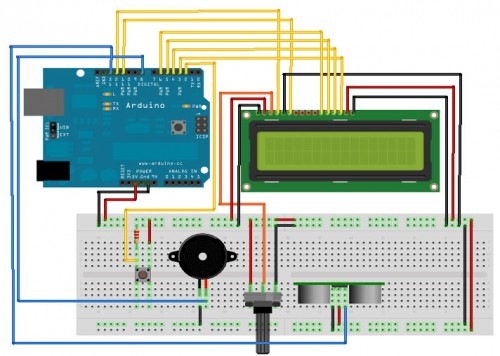

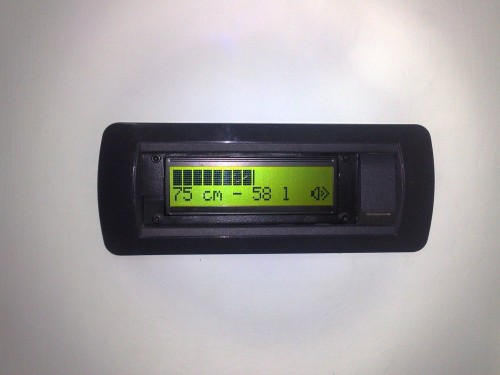
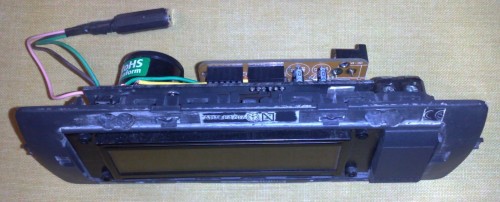


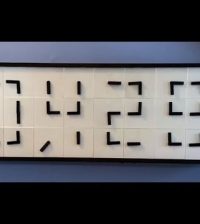
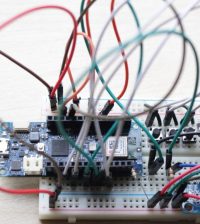











Pingback: Monitoring water levels with a Parallax Ping sensor - Hack a Day
Pingback: Please some help me.
Pingback: Water Tank level display with Arduino | Arduino in the Classroom | Scoop.it
Pingback: SuperHouse Automation